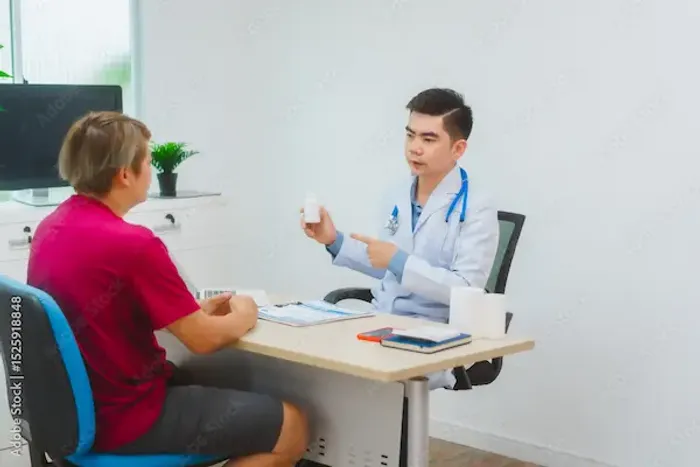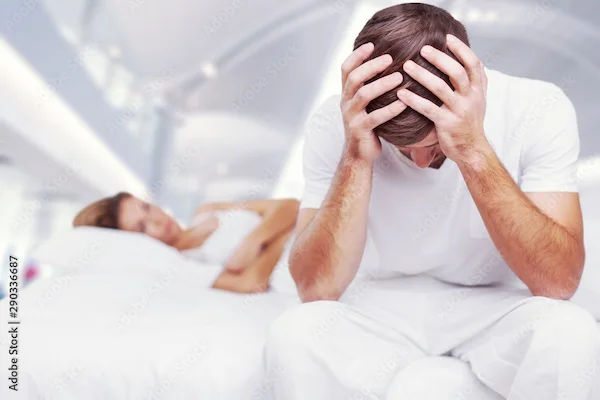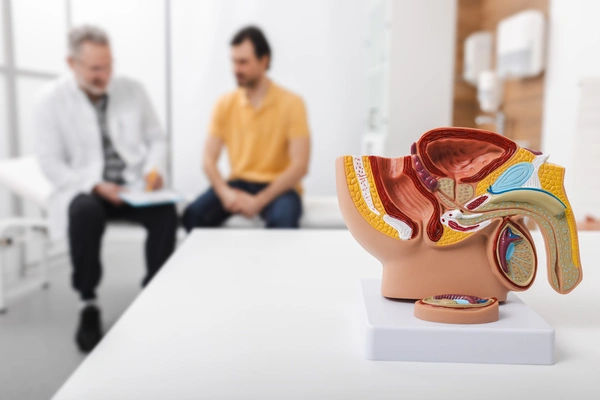What Leads To Signs Of Erectile Dysfunction Prevention Tips
Learn effective ways to prevent erectile dysfunction by understanding its causes, early warning signs, and practical lifestyle changes. Discover how heart health, hormones, sleep, stress, and exercise influence erectile function, and get a 30-day plan to stay proactive about men’s sexual health.


Introduction
Erectile dysfunction isn’t just a bedroom problem—it’s often a window into your overall health. Because erections rely on healthy blood vessels, balanced hormones, responsive nerves, and a relaxed mind, trouble in any of these areas can show up as sexual difficulties before other symptoms do. The good news? Many of the biggest drivers of erectile problems are preventable or improvable with smart daily choices.
In this guide, we’ll explain what leads to signs of erectile dysfunction, how to spot early warning clues, and the most effective prevention strategies backed by research. You’ll learn the heart–erection connection, simple lifestyle moves that protect vascular health, the role of sleep and stress, which medicines and habits to review, and which labs and screenings matter. We’ll also share a practical 30-day prevention plan and evidence-based tips—from Mediterranean-style eating to pelvic floor training—to help you take control. If signs persist or you have questions about tests and treatments, we’ll cover when to talk with a clinician. Let’s get you clear, confident, and proactive about erectile dysfunction prevention.
Understanding ED and why Prevention Matters
Erections depend on blood flow into the penis, where smooth muscle relaxes and traps blood in the erectile tissue. The process is coordinated by the nervous system, fuelled by nitric oxide released from blood vessels, and supported by hormones—especially testosterone—and a calm, engaged mind. When any link falters, erectile difficulties can appear.
How common is ED? It’s very common—affecting an estimated 30 million men in the U.S. alone, with prevalence rising with age, weight, and cardiometabolic risk factors. The Massachusetts Male Aging Study found that some degree of ED affects more than half of men between 40 and 70, with moderate-to-complete ED increasing with each decade. Importantly, ED often shares roots with heart disease and diabetes: the same endothelial (blood vessel lining) dysfunction that narrows coronary arteries also impairs penile blood flow. That’s why prevention matters—it protects sexual function and overall health simultaneously.
What ED is and how erections work
- Vascular: Nitric oxide–mediated smooth muscle relaxation and blood trapping.
- Neurologic: Brain arousal, spinal cord signals, peripheral nerve integrity.
- Hormonal: Adequate testosterone supports libido and nocturnal erections.
- Psychological: Anxiety, distraction, and relationship strain can inhibit arousal.
How common ED is, and why it’s more than a bedroom issue
- Common and under-reported.
- Strongly linked to cardiovascular and metabolic health; prevention yields whole-body benefits.
The big picture: blood vessels, nerves, hormones, and mind
- Most men have a mix of factors; prevention works best when it addresses all four.
Early Signs you Shouldn’t Ignore
Erectile problems usually develop gradually. Early clues can include reduced firmness, less reliable erections, longer time to achieve penetration, or difficulty maintaining during intercourse. A particularly useful clue is the frequency and quality of morning erections. Consistent morning erections suggest intact neurologic and hormonal pathways; a decline may point toward vascular or hormonal contributors, sleep disruption, or stress.
If you notice changes persisting for more than a few weeks, especially alongside fatigue, breathlessness, chest discomfort, new snoring, or leg cramping during walks, it’s wise to check in with a clinician. Many men benefit from a short screening questionnaire such as the IIEF-5 (International Index of Erectile Function), which gives a quick baseline and helps track progress over time.
Subtle clues before full-blown ED
- Less spontaneous arousal, more effort needed.
- Decline in morning erections.
- Difficulty maintaining firmness through intercourse.
Morning erections as a health barometer
- Reflect neurohormonal and vascular health; persistent loss warrants evaluation.
When to talk to a clinician
- Symptoms persisting beyond two weeks or worsening.
- Red flags: chest pain, severe fatigue, leg pain with walking, or depression symptoms.
If symptoms persist beyond two weeks, consult a doctor online with Apollo 24|7 for further evaluation.
Root Causes and Risk Factors you can Change
Most preventable ED risk stems from cardiometabolic factors: high blood pressure, high LDL, insulin
resistance/diabetes, obesity (especially abdominal), and inactivity. These conditions damage endothelial cells, reduce nitric oxide, and stiffen arteries—impairing penile blood flow first because penile arteries are small.
Smoking dramatically increases ED risk via vascular injury. Heavy alcohol use can dampen arousal and testosterone.
Certain recreational drugs (cocaine, methamphetamine, opioids) impair both brain arousal and hormones.
Medications can contribute: some antidepressants (particularly SSRIs/SNRIs), certain blood pressure medicines (older beta-blockers, thiazide diuretics), finasteride/dutasteride (for prostate/hair) in some men, opioids, and some
antihistamines and antipsychotics. Never stop a prescribed medication on your own. Instead, discuss alternatives (e.g., switching to an angiotensin receptor blocker for blood pressure) with your clinician.
Cardiometabolic drivers
- Hypertension, diabetes, dyslipidaemia, central obesity.
- Insulin resistance and elevated HbA1c strongly correlate with ED.
Smoking, alcohol, and recreational drugs
- Smoking cessation reduces ED risk and can improve function within months.
- Limit alcohol to low–moderate intake; avoid binges.
Medications to review
- Talk to your doctor about alternatives if ED begins after a new medicine.
The Heart–erection Connection
Men with ED have a higher risk of future cardiovascular events, independent of traditional risk factors. A leading explanation is the artery-size hypothesis: because penile arteries are narrower than coronary arteries, the same amount of plaque or endothelial dysfunction impairs erections earlier—often by 2–5 years—before heart symptoms surface. This makes ED a practical prompt to evaluate blood pressure, lipids, blood sugar, and lifestyle.
In primary care and cardiology clinics, ED now often triggers cardiovascular risk screening. For men under 60 with new-onset ED, asking about family history of heart disease, checking waist circumference, blood pressure, fasting lipids, and HbA1c is a non-invasive way to find hidden risk and prevent events. Many men first discover they have prediabetes or high blood pressure during an ED workup.
ED as an early warning for cardiovascular disease
- ED often precedes angina or heart attack by several years.
The artery-size hypothesis explained
- Smaller penile arteries “signal” vascular trouble earlier than coronary arteries.
Practical screening based on ED
- Prioritise BP, fasting lipids, HbA1c, smoking status, family history, and activity level.
Lifestyle prevention pillars
Diet: A Mediterranean-style pattern—vegetables, fruits, legumes, whole grains, nuts, olive oil, fish; minimal ultra-processed foods and added sugars—is associated with better endothelial function and reduced ED risk. Several studies link higher Mediterranean adherence with improved erectile function scores. Emphasise nitrate-rich vegetables (leafy greens, beets) to support nitric oxide bioavailability.
Exercise: Aerobic exercise improves endothelial function and raises nitric oxide availability; resistance training builds insulin sensitivity. Meta-analyses suggest about 160 minutes per week of moderate-to-vigorous aerobic activity can improve erectile function scores by several points, particularly in men with cardiovascular risk factors. Brisk walking, cycling with proper saddle fit, swimming, or intervals are all acceptable options—aim for consistency.
Weight: Abdominal fat is metabolically active and reduces testosterone while promoting inflammation. In randomised lifestyle programmes, weight loss and improved fitness have restored erectile function in a meaningful subset of obese men. Even 5–10% weight loss can enhance libido, energy, and erectile firmness. Pair protein-rich meals with fibre and strength training to preserve lean mass.
Food patterns that support blood flow
- Mediterranean-style, nitrate-rich greens, limit ultra-processed foods and sugar.
Exercise prescriptions
- 150–200 minutes/week aerobic plus 2 strength days; sitting breaks every 30–60 minutes.
Weight and waist
- Aim for a waist circumference below half your height; monitor trends, not perfection.
Consult Top Specialists Here
Sleep, Stress, and Relationships
Sleep apnoea is common and underdiagnosed in men with ED. Nightly drops in oxygen and surges in stress hormones damage vessels and blunt testosterone. Treating moderate-to-severe sleep apnoea with CPAP has been shown to improve erectile function scores in many men. If you snore loudly, feel unrefreshed, or your partner notices pauses in breathing, seek evaluation.
Stress and anxiety trigger the sympathetic “fight or flight” response, which is the opposite of “rest and digest” required for erections. Performance anxiety, pornography overuse, and unresolved relationship tensions can inhibit arousal.
Cognitive-behavioural strategies, mindfulness, and sensate focus exercises—often guided by a sex therapist—can break the anxiety-avoidance cycle. Combining psychological support with physical health changes delivers the best results.
Pelvic floor training (Kegels for men) can improve rigidity and venous sealing during erections. In clinical trials, supervised pelvic floor muscle training improved erectile function, especially in men with mild-to-moderate symptoms or post-prostate surgery. Consider a few sessions with a pelvic floor physiotherapist to learn proper technique.
Sleep apnoea and nocturnal oxygen
- CPAP improves erectile function in many men with OSA.
Anxiety, porn, and performance pressure
- Gradual exposure and communication help; consider sex therapy.
Pelvic floor training
- Targeted exercises can enhance rigidity and control; seek professional guidance.
Medications, Substances, and Environmental Factors
Review your current prescriptions if ED starts or worsens after a medication change. Some antidepressants, older beta-blockers, thiazide diuretics, finasteride/dutasteride, opioids, and antipsychotics are common contributors. Safer substitutes often exist; e.g., switching certain blood pressure drugs to ACE inhibitors or ARBs. Always make changes with clinician guidance.
Alcohol has a dose–response curve. While low-to-moderate intake may have neutral effects, heavy or binge drinking impairs erections acutely and chronically. Recreational substances can harm nerve signalling and hormones.
Environmental and ergonomic issues matter too. Long hours on poorly fitted bicycle saddles can compress perineal nerves and vessels. If you cycle frequently, prioritise bike fit, consider a noseless or centre-cut saddle, use padded shorts, and take brief standing breaks every 10–15 minutes on long rides.
Supplements are a mixed bag. Some evidence supports L-arginine/L-citrulline (nitric oxide precursors), Panax ginseng, and pycnogenol combinations for mild ED, but quality and dosing vary and interactions exist. Yohimbine and “gas station” blends are risky. Discuss supplements with a clinician, especially if you take nitrates or blood pressure medications.
Medicine review
- Ask about alternatives if ED begins after starting a new prescription.
Alcohol and recreational drugs
- Avoid binges; steer clear of stimulants and opioids that impair sexual function.
Ergonomics and supplements
- Correct cycling setup; stick to evidence-based supplements with clinician input.
Screening, Labs, and Professional Care
A sensible prevention workup checks the common, modifiable drivers:
- Blood pressure (ambulatory or home readings help).
- Fasting lipid profile (LDL, HDL, triglycerides).
- HbA1c or fasting glucose for insulin resistance/diabetes.
- Morning total testosterone (repeat if low; consider free T if borderline).
- Thyroid-stimulating hormone (TSH) if symptoms suggest thyroid issues.
- Consider prolactin if low libido or gynaecomastia present.
Depending on your history, your clinician may screen for depression/anxiety, sleep apnoea (STOP-Bang), and medication contributors. Imaging or specialised tests are rarely needed initially.
If your condition does not improve after trying these methods, book a physical visit to a doctor with Apollo 24|7. Apollo 24|7 also offers convenient home collection for tests like HbA1c, lipid panel, and vitamin D, helping you track progress without clinic hassle.
What tests may be useful
- BP, lipids, HbA1c, morning testosterone, TSH; targeted labs based on history.
When to seek care and what to expect
- Earlier is better—especially if you have other risk factors or sudden onset ED.
Coordinating care
- Primary care, urology, cardiology, and behavioural health can all contribute.
A Practical 30-day Prevention Blueprint
Week 1: Assess and set baselines
- Track IIEF-5, morning erections, energy, sleep, steps. Start a simple erection diary.
- Order labs (BP, lipids, HbA1c; testosterone if indicated). Use Apollo 24|7 home collection if convenient.
- Begin Mediterranean-style meals: add one large salad daily; swap sugary drinks for water or unsweetened tea.
- Move daily: 20 minutes brisk walking; stand up every 30–60 minutes at work.
Week 2: Build aerobic capacity and sleep quality
- Increase cardio to 120 total minutes/week (e.g., 4 sessions x 30 min).
- Fix sleep window (7–8 hours), reduce late screens, and screen for snoring/apnoea if present.
- Add nitrate-rich vegetables (spinach, arugula, beetroot) to support nitric oxide.
Week 3: Strength and stress
- Add two 20–30 minute resistance workouts (full-body).
- Start 10 minutes/day of relaxation training (box breathing, mindfulness).
- Alcohol audit: aim for no more than 1 drink/day (men), with some zero-drink days.
Week 4: Fine-tune and review
- Add pelvic floor training: 3 sets of 10 contractions, 3–4 days/week; consider guidance if unsure.
- Medication check-in with your clinician if ED began after a new prescription.
- Reassess IIEF-5, morning erections, and energy; plan next 30 days.
Tools: Use a wearable for step count and sleep; note correlations between better sleep and better erections. If you cycle, ensure proper fit and a cutout or noseless saddle.
Conclusion
Erectile dysfunction is common, but the most powerful levers for prevention are in your daily routine. Because ED often reflects early vascular changes, treating it as a health signal—not just a sexual symptom—puts you in control. Focus on the pillars with the biggest payoff: Mediterranean-style eating, consistent aerobic and strength exercise, trimming waist size, prioritising sleep, and managing stress. Add in targeted steps—quit smoking, review medications, fit your bike if you ride, and consider pelvic floor training—to stack the odds in your favour. Track your progress using the IIEF-5 and simple logs for morning erections, sleep, and activity, and recheck labs like BP, lipids, and HbA1c to see your inside-out gains. If your symptoms persist or you’d like tailored guidance, consult a doctor online with Apollo 24|7 or book a visit for a personalised plan. Prevention is proactive—and with steady steps, better erections and better health often arrive together.
Consult Top Specialists Here
Consult Top Specialists Here

Dr Karthik Maripeddi
Urologist
13 Years • MBBS MS FMAS MCh URO(OSM)
Hyderguda
Apollo Hospitals Hyderguda, Hyderguda

Dr. K Samyuktha
Urogynaecologist
12 Years • MBBS,MS (OSM), MCH UROLOGY (OSM) CONSULTANT UROLOGIST; UROGYNAECOLOGIST
Secunderabad
Apollo Hospitals Secunderabad, Secunderabad

Dr. Pari M R
Urologist
28 Years • MBBS, MS, Mch (Uro)
Chennai
Apollo Speciality Hospitals OMR, Chennai
(75+ Patients)

Dr. Pavan Kumar S K
Urologist
11 Years • MBBS, MS , Mch( Urology) DNB (Urology)
Bengaluru
Apollo Clinic, JP nagar, Bengaluru

Dr Tharaka Mourya Nutulapati
Urologist
7 Years • MBBS, MS (General Surgery), Mch ( Urology)
Visakhapatnam
Apollo 24|7 Clinic - Andhra Pradesh, Visakhapatnam
Consult Top Specialists Here

Dr Karthik Maripeddi
Urologist
13 Years • MBBS MS FMAS MCh URO(OSM)
Hyderguda
Apollo Hospitals Hyderguda, Hyderguda

Dr. K Samyuktha
Urogynaecologist
12 Years • MBBS,MS (OSM), MCH UROLOGY (OSM) CONSULTANT UROLOGIST; UROGYNAECOLOGIST
Secunderabad
Apollo Hospitals Secunderabad, Secunderabad

Dr. Pari M R
Urologist
28 Years • MBBS, MS, Mch (Uro)
Chennai
Apollo Speciality Hospitals OMR, Chennai
(75+ Patients)

Dr. Pavan Kumar S K
Urologist
11 Years • MBBS, MS , Mch( Urology) DNB (Urology)
Bengaluru
Apollo Clinic, JP nagar, Bengaluru

Dr Tharaka Mourya Nutulapati
Urologist
7 Years • MBBS, MS (General Surgery), Mch ( Urology)
Visakhapatnam
Apollo 24|7 Clinic - Andhra Pradesh, Visakhapatnam
More articles from Erectile Dysfunction
Frequently Asked Questions
Q1. Can erectile problems be reversed with lifestyle changes alone?
Many men see meaningful improvement with lifestyle changes—exercise, weight loss, and a Mediterranean diet—especially when ED is mild to moderate and related to vascular health. Results often appear within 8–12 weeks. For persistent cases, combine lifestyle with medical care. Try lifestyle changes for ED prevention first.
Q2. Which supplements are worth considering for prevention?
Limited evidence supports L-arginine/L-citrulline, Panax ginseng, and pycnogenol in mild cases. Quality matters, and interactions exist. Avoid “herbal Viagra” products. Discuss supplements with your clinician, particularly if you take nitrates or blood pressure meds.
Q3. How does diabetes affect erectile function?
High blood sugar damages blood vessels and nerves, increasing ED risk. Lowering HbA1c, improving insulin sensitivity through diet and exercise, and managing blood pressure and lipids are central to erectile dysfunction prevention in diabetes. Apollo 24|7 offers home collection for HbA1c tests.
Q4. Do antidepressants cause ED, and what can I do?
Some antidepressants (especially SSRIs/SNRIs) can reduce libido or impair erections. Never stop medications on your own—speak with your clinician about dose adjustments, switching agents, or adding strategies to counter side effects.
Q5. Is cycling bad for erections?
With proper bike fit, a supportive noseless or centre-cut saddle, padded shorts, and periodic standing breaks, most men can cycle safely. Prolonged pressure with poor setup raises risk; ergonomics are key to erectile dysfunction prevention for avid cyclists.

_0.webp)


